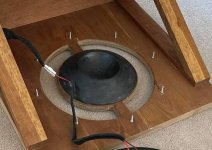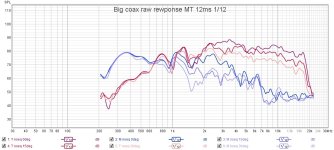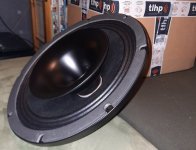Looking at some photos of open baffle stuff and this one comes up... One calls it slot loaded, another calls it horn loaded.
Technically I suppose I'm curious of:
Maybe it's neither etc, I was just curious "what the folks at diyaudio called it" etc. Thanks
Technically I suppose I'm curious of:
- what the ring type relief is called?
- does the phase plug simply avoid the flat slapback of leaving that central portion untreated?
- is this slot or horn loading?
Maybe it's neither etc, I was just curious "what the folks at diyaudio called it" etc. Thanks
Attachments
I have never seen that before!
What is the origin of the pic? Does the maker have an explanation? Measurements?
What is the origin of the pic? Does the maker have an explanation? Measurements?
It's from an open baffle guy on a group I'm in.
He has a YouTube video... And one of the comments there was a horn loading vs slot loading debate. Just curious what if anything was the term for a phase plugged (thanks Charles, suspected but wasn't sure) and slotted woofer... If that is even considered "slotted".
I know at one point there was mention of no measurements and tuning by ear, so I stopped really paying attention to 25 minute long videos ecpecting any. Figured if anyone's measured it'd be here.
I'm not trying to start anything I am just curious and wasn't sure if it was anything folks here had tried. I know I've seen the plugs on some JBL array horns using I think 2251Js if memory serves? Maybe I'm totally wrong there 😂
He has a YouTube video... And one of the comments there was a horn loading vs slot loading debate. Just curious what if anything was the term for a phase plugged (thanks Charles, suspected but wasn't sure) and slotted woofer... If that is even considered "slotted".
I know at one point there was mention of no measurements and tuning by ear, so I stopped really paying attention to 25 minute long videos ecpecting any. Figured if anyone's measured it'd be here.
I'm not trying to start anything I am just curious and wasn't sure if it was anything folks here had tried. I know I've seen the plugs on some JBL array horns using I think 2251Js if memory serves? Maybe I'm totally wrong there 😂
Last edited:
Using such a restriction in front of the woofer adds a little mass to the cone, just like slot 'loading'. That reduces how much equalization is required. It is a small effect usually. I guess it is mainly done for aesthetics in your example.
The cavity in front of the woofer acts as a Helmholtz resonator, with a corresponding resonance. The black plug reduces the volume and pushes the resonance frequency up, away from the range that the woofer plays.
It is not really a phase plug. Those are designed to avoid destructive interference due to path length differences. But this is a woofer, which only plays low frequencies. The wavelengths are so long that these path length differences do not matter.
The cavity in front of the woofer acts as a Helmholtz resonator, with a corresponding resonance. The black plug reduces the volume and pushes the resonance frequency up, away from the range that the woofer plays.
It is not really a phase plug. Those are designed to avoid destructive interference due to path length differences. But this is a woofer, which only plays low frequencies. The wavelengths are so long that these path length differences do not matter.
Last edited:
The cone volume filler plug does not really provide much "compression loading" without a horn attached to it to make it an acoustical impedance transformer from a low impedance to a high impedance.perhaps it called be called 'compression loading'
TBTL covered what the cone volume filler plug with the ring slot does in post #6, which is not much in an open baffle..
The appeal of "slot loading" is shrouded in mystery, so it wouldn't pay to assume every single example has achieved something.
I'm willing to guess (without seeing the vid) that the builder was conscious of the "free air" nature of the cone without an enclosure and wanted to add some constructive loading.
However some knowledgeable members don't believe that 'loading' comes into it and is not an appropriate term, and that if anything it just low-passes the response.. of course in the above example, there is no chamber so that doesn't happen.
I'm willing to guess (without seeing the vid) that the builder was conscious of the "free air" nature of the cone without an enclosure and wanted to add some constructive loading.
However some knowledgeable members don't believe that 'loading' comes into it and is not an appropriate term, and that if anything it just low-passes the response.. of course in the above example, there is no chamber so that doesn't happen.
I'm not trying to start anything I am just curious and wasn't sure if it was anything folks here had tried. I know I've seen the plugs on some JBL array horns using I think 2251Js if memory serves? Maybe I'm totally wrong there 😂
Yeah your right but phase plug more than one slot much narrower for a meaningful compression ratio and more importantly loaded with a horn back sealed. CMCD
Open baffle subs?
Rob 🙂
Attachments
Re:'The appeal of "slot loading" is shrouded in mystery' - indeed, lots of handwaving and a paucity of science if one tries to investigate
From the video: "...some of the tightest, cleanest, punchy, natural, organic, textured bass that I have literally ever heard". It must be very good indeed if it can impress someone in the influencer fraternity that much. However, a spectral analysis of the sample recordings indicates that there is not much bass below 40Hz, which serves to explain the superlatives. 🤔

Last edited:
Again, I can't explain as I am not well versed but had seen the printed plug or whatever you wanted to call it and it was interesting enough to inquire here about.
I am not gonna harp on the guy outside of the fact that he's got some interesting takes on some things and seems to be working with a particular manufacturer and pushing their product. He's kind of doing a Hawthorne-esque thing I guess with coaxial open baffles and bass woofers.
I've used slot loaded bass woofers with open baffle, but make no claims due to not having any measures. Whereas an MJK H frame is a little more proven as I own some and have seen his measures. So I believe my ears.
As for demo tracks, I can't gauge much due to some of the music people choose and it's just a recording.
Makes sense. My friend, the eternal critic, doesn't like bass he can't feel... Doesn't like the look of DIY... And claims we all need use terrible demo music to demo our systems and he's never heard us listen to anything "good" 😂
I am not gonna harp on the guy outside of the fact that he's got some interesting takes on some things and seems to be working with a particular manufacturer and pushing their product. He's kind of doing a Hawthorne-esque thing I guess with coaxial open baffles and bass woofers.
I've used slot loaded bass woofers with open baffle, but make no claims due to not having any measures. Whereas an MJK H frame is a little more proven as I own some and have seen his measures. So I believe my ears.
As for demo tracks, I can't gauge much due to some of the music people choose and it's just a recording.
Makes sense. My friend, the eternal critic, doesn't like bass he can't feel... Doesn't like the look of DIY... And claims we all need use terrible demo music to demo our systems and he's never heard us listen to anything "good" 😂
It should behave the same as a woofer mounted behind a simple baffle with a small hole cut in it. The plug would only help it work at a higher frequency than before (likely higher than it's being used).the printed plug or whatever you wanted to call it and it was interesting enough to inquire here about.
What I noticed was that nothing technical was mentioned.He's kind of doing a Hawthorne-esque thing I guess
Allen, that was my biggest takeaway, not a lot of technical speak. Lots of bu So I came here to avoid ruffling feathers. I know they use a spacer to "align" the compression driver and woofer, as well as only using first order crossovers, etc.
I don't believe the crossover was redesigned.. but they did leave a clue as to which channel the ideas came from.I know they use a spacer to "align" the compression driver and woofer, as well as only using first order crossovers, etc.
In any case I decided to simulate a dipole on a baffle, with a removable obstruction.
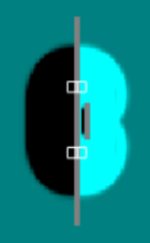
Here it can be seen that at lower frequencies, not much happens.

At higher frequencies..
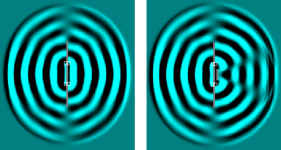
The concept this guy is using is fundamentally wrong, crazy.
- open baffle for low bass....
- obstructing the frontside to make it's radiating area smaller...
- making front- and backside radiation more asymmetric...
My guess of what the plug really does
- increasing air velocity at slots, making nearfield measurement to show higher spl
- increasing distortion in many ways
- adding noises from air passing through slots at high spl
- increasing resonances showing as spl wiggles above 600Hz
I have measured a PA coaxial with a horn close to the 12" woofer
- open baffle for low bass....
- obstructing the frontside to make it's radiating area smaller...
- making front- and backside radiation more asymmetric...
My guess of what the plug really does
- increasing air velocity at slots, making nearfield measurement to show higher spl
- increasing distortion in many ways
- adding noises from air passing through slots at high spl
- increasing resonances showing as spl wiggles above 600Hz
I have measured a PA coaxial with a horn close to the 12" woofer
Attachments
I'm not saying I see anything right or wrong.
Just outside the box of what I've seen folk usually doing. In theory what he's doing with the ring I think is sticking to the 1/3 of surface area ratio that Nelson Pass had in his SLOB paper. In that case too, it's a smaller front than back opening, but pass mentions an air velocity increase out the front... I forget his exact results, but I get why he's doing what he's doing when it comes to "bass".
That said, I used to run quad Goldwood 18s and never really played with subs or the need for subs, but OB wouldn't be my first instinct if adding bass to a system. That said, I've used a Goldwood under each of my Dynaco A25 and we were surprised how good it sounded, so I would never write off an open baffle sub without hearing it.
Im not trying to call into question any choices made, just wanted to know about the 3D printed part on my original post.
Just outside the box of what I've seen folk usually doing. In theory what he's doing with the ring I think is sticking to the 1/3 of surface area ratio that Nelson Pass had in his SLOB paper. In that case too, it's a smaller front than back opening, but pass mentions an air velocity increase out the front... I forget his exact results, but I get why he's doing what he's doing when it comes to "bass".
That said, I used to run quad Goldwood 18s and never really played with subs or the need for subs, but OB wouldn't be my first instinct if adding bass to a system. That said, I've used a Goldwood under each of my Dynaco A25 and we were surprised how good it sounded, so I would never write off an open baffle sub without hearing it.
Im not trying to call into question any choices made, just wanted to know about the 3D printed part on my original post.
- Home
- Loudspeakers
- Multi-Way
- What is this technique called?
